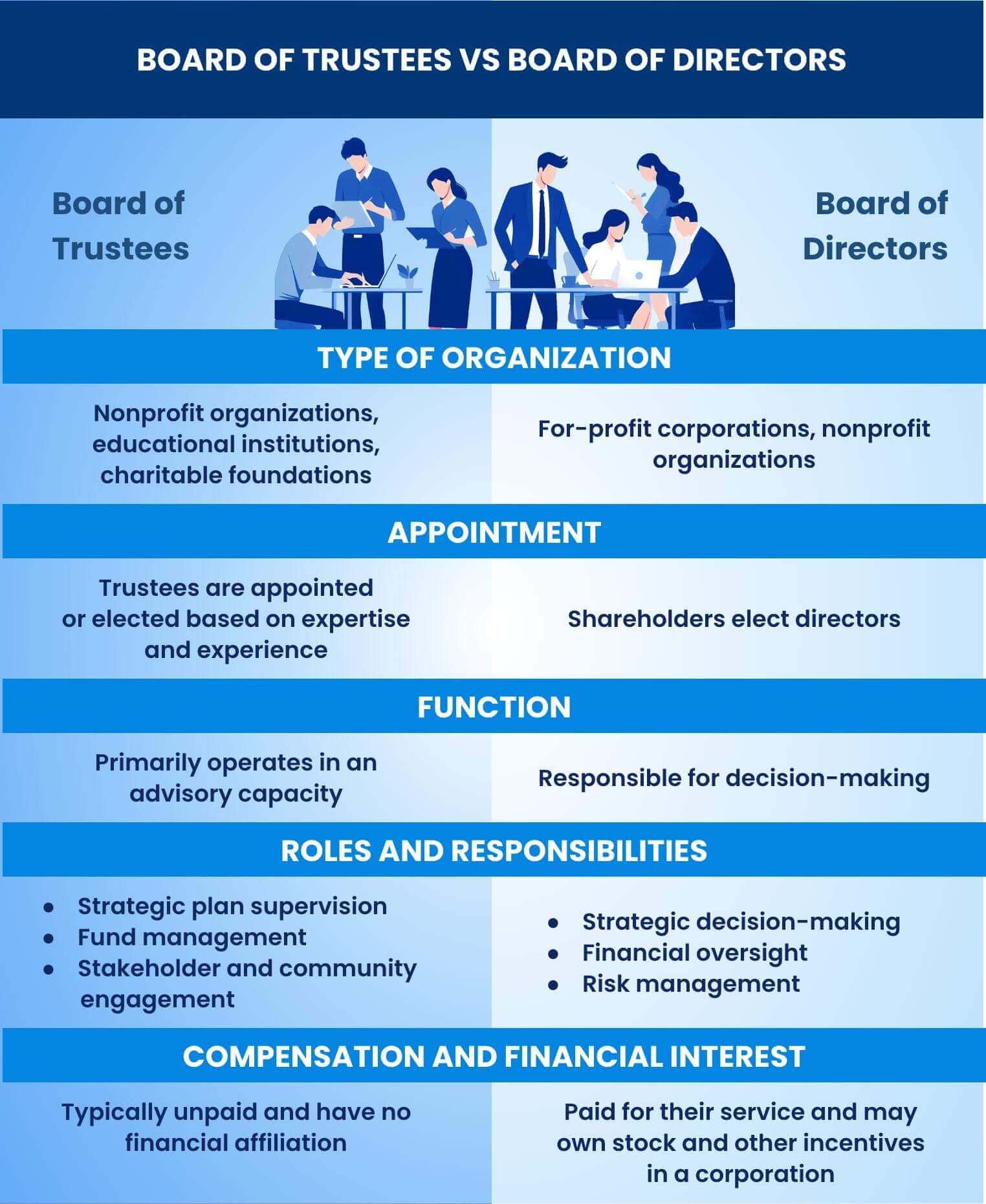Every business needs a governing body to spearhead the decision-making processes and steer the organization toward its goals. In this article, we will tackle the two common types of leadership: boards of trustees vs boards of directors.
While their names are used interchangeably on certain occasions, they are not meant to operate similarly. One way to tell them apart is that a board of trustees governs a nonprofit organization or a trust, while a board of directors typically leads a for-profit business. However, note that a board of directors can also serve as the head of a nonprofit.
If you’re still confused, this article highlights the difference between board of directors and board of trustees by specifying their roles and responsibilities in companies and organizations.
What is a Board of Trustees?
Understanding the distinction between a board of trustees and a board of directors starts with knowing their respective organizational roles. So, what is a board of trustees?
The trustees advise the senior leadership on financial matters, but their role heavily focuses on safeguarding the organization’s mission, assets, and well-being. For this reason, they are expected to put their fiduciary duties above all and are often held to a higher standard than other board directors.
They may function similarly to the board of directors in some organizations but are usually only present in a nonprofit setup. The board of trustees usually consists of a group of individuals appointed to oversee the management and direction of non-profit organizations, such as:
- Religious institutions
- Charitable foundations
- Hospitals
- Universities
- Art museums
Because their role revolves around serving the people, they must act in the stakeholders’ best interest and not their own. The structure of the trustees, including the board size, appointments, and term durations, is determined by state laws.
Function and Composition
With significant authority over managing funds, making investment decisions, and handling taxes, the board of trustees must ensure that its decisions benefit the organization in the long run and do not compromise its integrity. Commonly, the board of trustees has the financial expertise or legal background to make sound judgments. But they should come from diverse industries, with the right mix of skills, to ensure a well-rounded governing body.
There is no required number of trustees as the organization’s needs will determine it. But at least five members up to twelve, depending on the nonprofit’s size, is considered good practice.
What does a board of trustees do?

In a nutshell, the board of trustees sets and approves the organization’s significant policies and strategic goals, ensuring they align with its financial goals. They also help ensure compliance with charitable trusts, which vary by state and differ from laws for nonprofits, among other regulatory requirements.
Specifically, trustees are responsible for the following duties:
1. Overseeing annual strategic planning processes
This role may involve assessing the organization’s strengths and weaknesses, identifying opportunities and threats, and developing plans to achieve its mission effectively.
2. Participating in fundraising efforts
Trustees must actively engage in fundraising activities to support the nonprofit organization. These efforts include securing funds by seeking donations from individuals or businesses in their network, applying for grants, and implementing other fundraising strategies.
3. Establishing and maintaining relationships with donors
Building and nurturing relationships with donors is crucial for securing ongoing support for the organization. Thus, the trustees’ role in cultivating these relationships is essential. They should express gratitude, provide updates on the organization’s activities, and ensure transparency in how donated funds are used.
4. Supporting the organization’s engagement with the community
The trustees’ involvement in the community starts with being more engaged. This could involve participating in community events, collaborating with other local organizations, and seeking input from community members to ensure that the organization’s programs and services meet their needs.
5. Representing the interests of stakeholders
As previously mentioned, trustees have a fiduciary duty to act in the organization’s and its stakeholders’ best interests, including clients, employees, volunteers, donors, and the community. They must consistently engage with them to consider their diverse perspectives and needs when making decisions on behalf of the organization.
6. Serving as ambassadors for the nonprofit
Trustees are often seen as representatives of the organization and are responsible for promoting its mission and values to various stakeholders. In line with this, they are expected to speak at public events, network with potential partners, and use their influence to garner support.
They must uphold the organization’s reputation by maintaining high ethical standards, complying with legal and regulatory requirements, and addressing issues that may negatively impact the nonprofit’s standing in the community.
Pay and Notoriety
The members of a board of trustees are generally unpaid, as they volunteer their time out of dedication to the organization’s mission. However, some receive compensation in the form of reimbursements and stipends.
While the level of notoriety associated with trusteeship may vary depending on the organization’s prominence, trustees often hold esteemed positions within their respective communities and industries.
What is a Board of Directors?
A board of directors is a group of elected business leaders that are easily associated with the board of trustees because their role also revolves around:
- Guiding the strategic direction of an organization;
- Making important decisions;
- Selecting eligible top executives;
- And operating in the best interest of stakeholders.
They meet regularly, often monthly or quarterly, to discuss the strategies needed to drive the organization forward.
For public companies, it is obligatory to have a board of directors to represent the shareholders.
Function and Composition
What is the purpose of board of directors? Contrary to the board of trustees, the board of directors primarily governs for-profit corporations. It oversees the company’s operations, strategy, and performance. The board consists of shareholder-elected internal executives and external experts.
In the case of nonprofit boards, they focus more on aligning the mission and vision to the organization’s overall strategy.
Read the difference between a for-profit and nonprofit board function here.
What does the board of directors in a corporation do?

The key functions of a corporation’s board of directors include strategic decision-making, financial oversight, risk management, and ensuring accountability to shareholders. They must uphold the organization’s values and objectives while adhering to legal and ethical standards.
Here are the common duties of a board director:
1. Strategizing and setting the organization’s direction
Board directors analyze internal and external factors, such as market trends, competition, and organizational capabilities, to develop strategies to achieve its objectives over time.
2. Managing risks and assets
The purpose of board of directors is also vital to the company’s risk management processes. They guide the organization in identifying, assessing, and mitigating potential risks that could impact its operations, finances, reputation, or stakeholders. Additionally, they monitor asset management, including financial resources, properties, and intellectual property, to ensure they are utilized effectively and aligned with the organization’s mission.
3. Creating committees to help streamline decision-making
Boards often establish committees, such as finance, governance, fundraising, or program committees, to focus on specific areas of the organization’s operations. These committees help to streamline decision-making by conducting in-depth reviews and making recommendations to the entire board.
4. Hiring and evaluating top executives
A board director’s role also involves hiring, evaluating, and, if necessary, replacing the organization’s top executives. They work closely with management and the governance committee to establish performance criteria, provide feedback on performance, and ensure that executive compensation is fair.
5. Establishing governance policies to ensure compliance
Establishing these policies includes adopting codes of conduct, conflict of interest, whistleblower policies, and other governance frameworks.
6. Engaging with shareholders, employees, customers, and the community
As high-ranking executives, board members must engage with employees, customers, and community members through various channels, such as meetings, forums, and newsletters. By keeping them informed and involved in organizational activities, it promotes a culture of honesty and accountability.
Pay and Notoriety
As of April 2024, the average board member in a corporation salary in the United States typically falls between $87,297 and $139,814. Of course, this will depend on important factors, such as education and experience. Additionally, board directors may receive stock incentives.
The level of notoriety associated with directorship can vary depending on the company’s size, industry, and public profile. High-profile directors may enhance their reputations through their association with well-known corporations.
Board of Trustees vs Board of Directors
To give you an overview of the difference between board of directors and board of trustees, here is a table of comparison:

Frequently Asked Questions (FAQs)
Is an executive committee the same as a board of trustees?
While both oversee organizational governance, an executive committee is typically a subgroup within the board of trustees or board of directors, tasked with specific responsibilities delegated by the larger governing body.
What is the minimum number of members on a board?
Legal requirements or organizational bylaws often dictate the minimum number of board members. Smaller companies may have three to seven members, while larger companies can have up to 15 or more directors.
Can the board remove a director or trustee as a member?
Technically, the board cannot vote to oust the member, but that is often the next step. This typically happens if the member isn’t doing their job well, misbehaves, or has a conflict of interest. Once the board reaches a vote of no confidence, which indicates their disapproval of the director or trustee, the member’s position may become untenable, leading them to resign or face pressure to step down voluntarily.
How do boards ensure accountability and transparency in their decision-making processes?
Boards maintain accountability and transparency through regular reporting and board meetings, adherence to governance principles and regulations, independent audits, and open communication with stakeholders.
Can a nonprofit organization have both a board of trustees and a board of directors?
Yes, nonprofits may have both a board of trustees and a board of directors, although this is less common and will depend on the organization’s structure and legal requirements. The downside of this scenario is that decision-making will be less cohesive, as two governing bodies may have different priorities.
Elevate Board Leadership with Convene

Board meetings take up a good chunk of executive leadership’s time. There are many things to plan, discuss, and review to ensure the organization is heading in the right direction. Without the right tool to streamline this process, these meetings can become overwhelming and inefficient.
It doesn’t have to be that way with Convene.
The leading board portal, Convene, enhances engagement and interactivity in the boardroom by offering feature-rich tools designed to simplify decision-making. With Convene, trustees and directors can easily access and collaborate on documents, hold virtual meetings through secure audio and video conferencing, and receive real-time notifications to stay informed about updates and changes.
Features like Document Library provide the organization with secure storage and efficient management of company files for easy access to the board. During live meetings, Page Synchronization and Laser Pointer help participants stay engaged. At the same time, Review Rooms and voting and resolution features facilitate a streamlined approval process for resolutions that makes board decision-making more efficient.
By centralizing all meeting-related activities on one platform, Convene empowers the board of trustees and board of directors to make well-informed decisions and, more importantly, ensures that board meetings are productive and effective.
Book a demo with us today to learn how Convene can help elevate your board management.
Jess is a Content Marketing Writer at Convene who commits herself to creating relevant, easy-to-digest, and SEO-friendly content. Before writing articles on governance and board management, she worked as a creative copywriter for a paint company, where she developed a keen eye for detail and a passion for making complex information accessible and enjoyable for readers. In her free time, she’s absorbed in the most random things. Her recent obsession is watching gardening videos for hours and dreaming of someday having her own kitchen garden.


![How to Create a Board Skill Matrix + Template [Free Download]](https://cdn.azeusconvene.com/wp-content/uploads/2024Q3_Jul_Board-of-Directors-Skills-Matrix-Whitepaper-A-Light.png)








